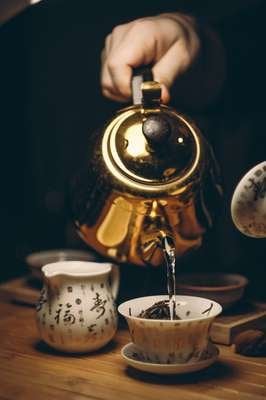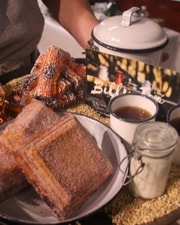You've been brewing tea all wrong! Discover the ancient Australian method that will totally transform your tea game!
By
Danielle F.
- Replies 8
Ah, tea – that quintessentially comforting brew that has warmed the hands and hearts of Australians for generations. Whether it's a robust black tea to kickstart the morning or a soothing herbal blend to unwind in the evening, tea holds a special place in many of our lives. But what if I told you that you might have been brewing it all wrong?
Recently, a wave of interest has swept across the nation as Australians have rediscovered a 'forgotten' tradition that promises to elevate the humble act of tea-making into an art form. This ancient method, known as 'turning the teapot,' is not just about tradition; it's about unlocking the full potential of your tea leaves.
The practice involves a simple yet precise ritual: after pouring boiling water into your teapot, you turn the pot clockwise three times, then anticlockwise three times. This method, which may seem like a quirky superstition at first glance, actually has roots that reach deep into history and across cultures.
A New South Wales resident sparked a lively discussion on Reddit when she shared her discovery of this 'correct way' to make tea. She had heard various reasons for the practice, ranging from 'for good luck' to 'to settle the leaves,' and 'to make the brew stronger.' Skeptical at first, she wondered if this was a genuine tradition or just a generational joke.
However, tea experts have weighed in to confirm that there's more to this ritual than meets the eye. Cara Chen, a tea connoisseur, explained to FEMAIL that the act of turning the teapot is steeped in the principles of traditional Chinese philosophy. In the Gongfu tea ceremony, for example, the direction in which the kettle is poured – anticlockwise rather than clockwise – is believed to influence the natural flow of energy (Qi) and promote harmony.
But it's not just about the spiritual aspects. The physical act of turning the teapot creates a circular current that agitates the water, ensuring that the tea leaves are evenly mixed and preventing them from clumping together. When you reverse the direction, you counteract the current, allowing the water to settle and the tea to steep without becoming over-extracted.
This practice isn't just confined to the Gongfu ceremony or to Chinese tea culture. In Australia, the billy tea ceremony – where tea is made over an open fire and the pot is swung around in a circle three times to settle the leaves – is a testament to the importance of movement in brewing. Some suggest that turning the teapot in domestic settings is a more refined adaptation of this rugged campfire tradition.
The 'turning the teapot' method has also been embraced in the UK, where it's considered an essential step in making a proper English tea. Australians living abroad have brought back this technique, adding a touch of ceremony and sophistication to their tea service when entertaining guests.
So, next time you're about to brew a pot of tea, why not give this ancient method a try? Whether you're a skeptic or a believer in the power of traditions, there's no denying that the ritual adds a layer of intention and care to the tea-making process. And who knows? You might just find that your tea tastes better for it.

At the Seniors Discount Club, we're all about preserving and sharing the wisdom of the past while enjoying the comforts of the present. So, we invite you to join in on this rediscovered tradition and share your experiences. Have you tried turning the teapot? Did you notice a difference in your tea? Share your stories and let's keep the conversation brewing!
Recently, a wave of interest has swept across the nation as Australians have rediscovered a 'forgotten' tradition that promises to elevate the humble act of tea-making into an art form. This ancient method, known as 'turning the teapot,' is not just about tradition; it's about unlocking the full potential of your tea leaves.
The practice involves a simple yet precise ritual: after pouring boiling water into your teapot, you turn the pot clockwise three times, then anticlockwise three times. This method, which may seem like a quirky superstition at first glance, actually has roots that reach deep into history and across cultures.
A New South Wales resident sparked a lively discussion on Reddit when she shared her discovery of this 'correct way' to make tea. She had heard various reasons for the practice, ranging from 'for good luck' to 'to settle the leaves,' and 'to make the brew stronger.' Skeptical at first, she wondered if this was a genuine tradition or just a generational joke.
However, tea experts have weighed in to confirm that there's more to this ritual than meets the eye. Cara Chen, a tea connoisseur, explained to FEMAIL that the act of turning the teapot is steeped in the principles of traditional Chinese philosophy. In the Gongfu tea ceremony, for example, the direction in which the kettle is poured – anticlockwise rather than clockwise – is believed to influence the natural flow of energy (Qi) and promote harmony.
But it's not just about the spiritual aspects. The physical act of turning the teapot creates a circular current that agitates the water, ensuring that the tea leaves are evenly mixed and preventing them from clumping together. When you reverse the direction, you counteract the current, allowing the water to settle and the tea to steep without becoming over-extracted.
This practice isn't just confined to the Gongfu ceremony or to Chinese tea culture. In Australia, the billy tea ceremony – where tea is made over an open fire and the pot is swung around in a circle three times to settle the leaves – is a testament to the importance of movement in brewing. Some suggest that turning the teapot in domestic settings is a more refined adaptation of this rugged campfire tradition.
The 'turning the teapot' method has also been embraced in the UK, where it's considered an essential step in making a proper English tea. Australians living abroad have brought back this technique, adding a touch of ceremony and sophistication to their tea service when entertaining guests.
So, next time you're about to brew a pot of tea, why not give this ancient method a try? Whether you're a skeptic or a believer in the power of traditions, there's no denying that the ritual adds a layer of intention and care to the tea-making process. And who knows? You might just find that your tea tastes better for it.
Key Takeaways
- Australians have reignited interest in an ancient tradition of 'turning the teapot' to improve tea brewing.
- The act of rotating the teapot clockwise and anticlockwise is said to bring good luck, settle leaves, and strengthen the brew.
- A tea expert explained that the Gongfu tea ceremony, which involves an anticlockwise pour, is aligned with Chinese philosophical principles to promote harmony and Qi flow.
- The tradition has parallels with an Aussie campfire practice of swirling billy tea to settle the leaves, and some suggest turning the teapot is a domestic adaptation of this ritual.
At the Seniors Discount Club, we're all about preserving and sharing the wisdom of the past while enjoying the comforts of the present. So, we invite you to join in on this rediscovered tradition and share your experiences. Have you tried turning the teapot? Did you notice a difference in your tea? Share your stories and let's keep the conversation brewing!








